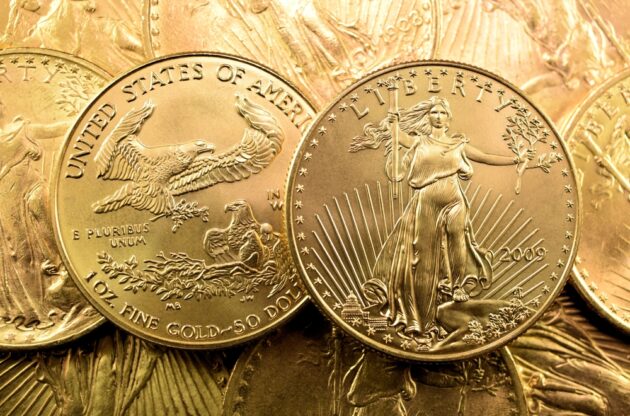
The American Gold Eagle stands as the United States’ flagship gold bullion coin, embodying American heritage, artistic excellence, and monetary value in a single tangible asset.
First authorized by the Gold Bullion Coin Act of 1985 and released in 1986, these coins have become the most recognized gold bullion products in America and among the most respected worldwide.
1. Historical Foundations and Origins
The American Gold Eagle emerged from specific historical and economic circumstances in the mid-1980s. After decades of restrictions on private gold ownership in the United States (1933-1974), Americans could once again freely own gold by the 1980s. However, the global gold coin market was dominated by the South African Krugerrand, which held approximately two-thirds of worldwide sales.
As anti-apartheid sentiment grew, President Reagan banned Krugerrand imports on October 11, 1985, creating an opportunity for an American alternative. Just two months later, on December 17, 1985, Reagan signed the Gold Bullion Coin Act, authorizing the creation of American Gold Eagles.
The legislation specified several key requirements:
- Four denominations: $50 (1 oz), $25 (1/2 oz), $10 (1/4 oz), and $5 (1/10 oz)
- 22-karat gold composition (91.67% gold, with remaining content being silver and copper)
- Specific design elements, including “a design symbolic of Liberty” on the obverse
- A reverse showing “a family of eagles, with the male carrying an olive branch and flying above a nest”
- Made exclusively from American gold—all gold used must come from newly mined domestic sources
The first American Gold Eagles were released on October 20, 1986, in all four denominations for bullion versions, while proof versions initially included only the one-ounce coins.
Did you know… When the Gold American Eagle was introduced, it was the first time the United States had minted gold coins for public circulation since 1933, when President Roosevelt recalled gold coins during the Great Depression.
2. Iconic Design Elements
The American Gold Eagle features designs of tremendous artistic and symbolic significance.
2.1 The Saint-Gaudens Obverse: Liberty’s Timeless Stride
The obverse of the American Gold Eagle features a rendition of Augustus Saint-Gaudens’ iconic Liberty design. This was originally created for the $20 gold Double Eagle first minted in 1907, stemming from President Theodore Roosevelt’s desire to beautify American coinage.
Saint-Gaudens, one of America’s most celebrated sculptors, created an image of Liberty in full stride, with flowing hair and robes, holding a torch in her right hand and an olive branch in her left. The U.S. Capitol building appears in the background.
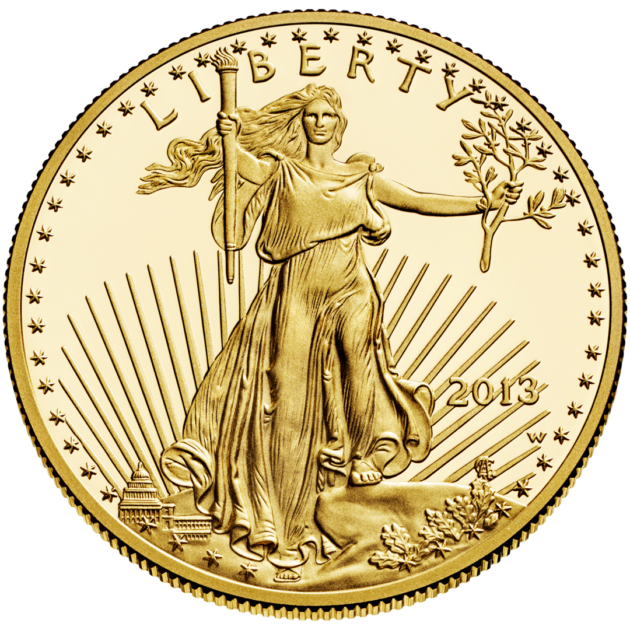
The design symbolizes America’s commitment to freedom and democracy, with the torch representing enlightenment and the olive branch representing peace. For the American Gold Eagle, the design was adapted with stars added to reflect Alaska and Hawaii joining the Union.
Did you know… The model for Lady Liberty on the American Gold Eagle was a mystery until 1991, when historical documents revealed she was Hettie E. Anderson, a Black woman whose family had fled slavery years before she was born. Despite the racism of the early 1900s, she became a favorite model for respected sculptors in New York City.
2.2 The Reverse Design: From Family to Pride and Wisdom
The American Gold Eagle has featured two distinct reverse designs:
The Busiek “Family of Eagles” (1986-2021)
Sculptor Miley Busiek (now known as Miley Tucker-Frost) created the original reverse design featuring a male eagle carrying an olive branch flying above a nest containing a female eagle and eaglets. This “Family of Eagles” design adorned the coins from 1986 to 2021.
Busiek’s inspiration came from Ronald Reagan’s 1980 acceptance speech, which focused on “New Beginnings” and Americans caring for each other. She explained her design as “a symbolic tribute to the American family, senior citizens, and young people.”
The Norris Eagle Portrait (2021-present)
In 2021, to commemorate the 35th anniversary of the program, the U.S. Mint introduced a completely new reverse design by artist Jennie Norris. This design features a close-up portrait of an eagle’s head, capturing what Norris described as “the intensity of his stare through the close cropping. His gaze speaks of pride and wisdom passed down through generations of time.”
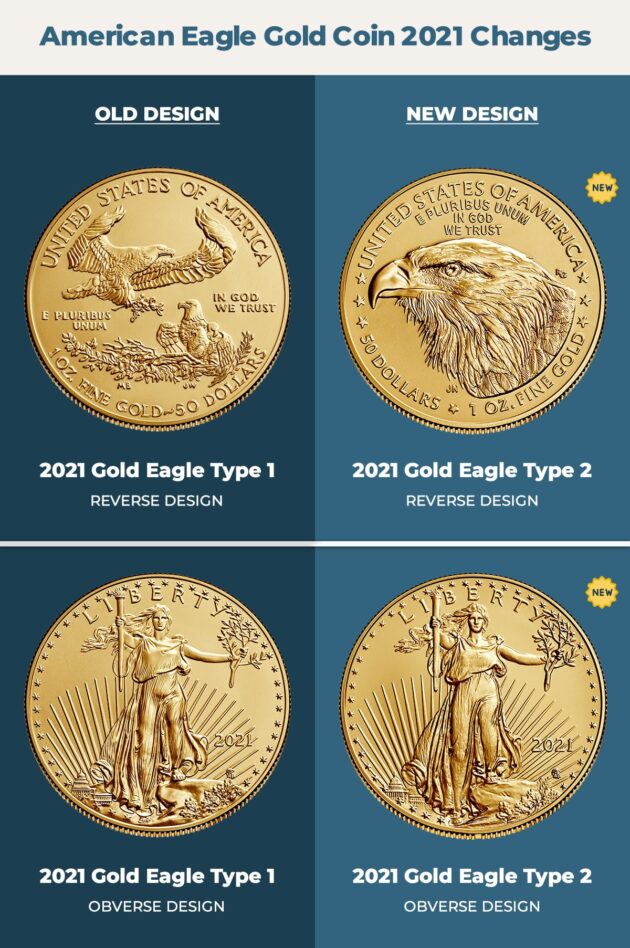
Norris, a former volunteer raptor handler with firsthand experience observing birds of prey, drew from this knowledge in creating her detailed design. The portrait dramatically shifts the focus from the family-oriented previous design to one emphasizing strength, vigilance, and nobility.
Did you know… The 2021 redesign of the Gold Eagle’s reverse was the first major change to the coin’s appearance since its introduction in 1986. Collectors refer to pre-2021 coins as “Type 1” and the new design as “Type 2” American Gold Eagles.
2.3 Notable Design Changes Over Time
Several other changes have occurred during the Gold Eagle’s history:
- 1986-1991: Dates appeared in Roman numerals (MCMLXXXVI through MCMXCI).
- 1992-present: The U.S. Mint switched to standard Arabic numerals.
- 2021: Along with the new reverse, the Saint-Gaudens obverse was subtly refreshed to return to closer fidelity to the original 1907 design elements.
2.4 Anti-Counterfeiting Innovations (2021-present)
One of the most significant developments has been the introduction of sophisticated anti-counterfeiting technology starting in 2021:
- A reed pattern interruption or “notch” on the edge of the coins, positioned differently each year:
- 2021: 6 o’clock position
- 2022: 7 o’clock position
- 2023: 3 o’clock position
- 2024: 9 o’clock position
- 2025: Position continues the annual pattern
The coins also contain undisclosed covert security features. The Mint established a new state-of-the-art Anti-Counterfeiting laboratory in Philadelphia to develop and test these authentication methods.
Did you know… The Gold Reserve Act of 1934 increased the official price of gold from $20.67 per ounce to $35 per ounce, encouraging foreign investors to export large quantities of gold to the United States, helping increase gold reserves in the Federal Reserve and U.S. Treasury.
3. Physical Specifications and Composition
American Gold Eagles are produced in four denominations, each with specific physical characteristics that have remained consistent since 1986 (with minor modifications in security features beginning in 2021).
3.1 Gold Content and Alloy Composition
All American Gold Eagles contain 22-karat gold (91.67% pure), with the remainder being:
- Silver: 3% (primarily for color)
- Copper: 5.33% (for durability and wear resistance)
This composition, known historically as “crown gold,” was chosen specifically to produce more durable coins compared to pure 24-karat gold. This traditional English standard had not been used in U.S. coins since 1834 before being revived for the Gold Eagle program.
Each coin contains exactly its stated weight in pure gold:
- 1 oz coin: 1.0000 troy oz of gold
- 1/2 oz coin: 0.5000 troy oz of gold
- 1/4 oz coin: 0.2500 troy oz of gold
- 1/10 oz coin: 0.1000 troy oz of gold
However, the total weight of each coin is slightly higher due to the added metals:
- 1 oz coin: 33.931 grams (1.0909 troy oz)
- 1/2 oz coin: 16.966 grams (0.5455 troy oz)
- 1/4 oz coin: 8.483 grams (0.2727 troy oz)
- 1/10 oz coin: 3.393 grams (0.1091 troy oz)
3.2 Physical Dimensions
Diameter:
- 1 oz coin: 32.70 mm
- 1/2 oz coin: 27.00 mm
- 1/4 oz coin: 22.00 mm
- 1/10 oz coin: 16.50 mm
Thickness:
- 1 oz coin: 2.87 mm
- 1/2 oz coin: 2.15 mm
- 1/4 oz coin: 1.78 mm
- 1/10 oz coin: 1.26 mm
All denominations feature a reeded edge, with the one-ounce coin having 161 reeds. Since 2021, all American Gold Eagles also feature an anti-counterfeiting edge notch that changes position annually.
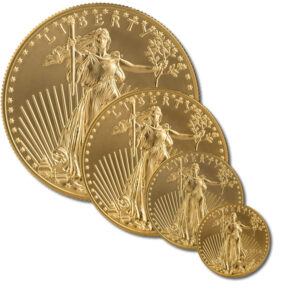
3.3 Face Values and Legal Tender Status
American Gold Eagles are legal tender coins with assigned face values:
- 1 oz: $50
- 1/2 oz: $25
- 1/4 oz: $10
- 1/10 oz: $5
While these denominations are significantly below the intrinsic gold value, the legal tender status adds government backing and authenticity. These coins must technically be accepted for payment of debts at face value, though this would be impractical given their much higher gold value.
3.4 Specification Summary Table
The following table summarizes the key specifications for all four denominations of American Gold Eagles:

Did you know… The 22-karat gold standard used in American Gold Eagles is actually based on a British tradition called “crown gold” that dates back to the reign of King Henry VIII. Despite being America’s national gold coin, it follows this English standard rather than using pure 24k gold!
4. The Complex Production Process of the Gold American Eagle Coins
The creation of American Gold Eagles involves a sophisticated, multi-stage process that combines traditional techniques with modern technology.
4.1 Sourcing American Gold
By law, the gold used in American Gold Eagles must come from sources within the United States. The U.S. Mint sources this gold from authorized bullion depositories, including its own reserves. This requirement ensures that the coins represent American mining capabilities and truly domestic production.
4.2 Creating the Gold Alloy
The process begins with the preparation of the specific 22-karat gold alloy:
- Raw gold is melted in a furnace alongside precisely measured amounts of silver and copper.
- The molten metal is carefully mixed to ensure uniform distribution of all metals.
- The liquid alloy is cast into large ingots.
4.3 Forming Blanks and Planchets
These ingots then undergo several transformations:
- The gold alloy ingots are heated and fed through powerful rolling mills, gradually reducing thickness.
- The resulting metal strips (approximately 13 inches wide and up to 1,500 feet long) are inspected for quality.
- Circular blanks are punched out by high-speed blanking presses.
- The blanks are heated in an annealing furnace to temperatures up to 1,600°F to soften the metal.
- After cooling in a quench tank, the blanks undergo an “upsetting” process that forms a raised rim.
- This rim protects the final design from wear and makes the coins stackable.
- At this stage, they become “planchets” ready for striking.
Did you know… The American Gold Eagle is the most commonly counterfeited gold coin in the world, with over 40% of gold coin dealers reporting having encountered fake Gold Eagles at some point. To combat this, the U.S. Mint has introduced additional security measures in recent years.
4.4 Die Creation and Preparation
The designs are transferred to production dies through several steps:
- Artists create detailed designs that are digitally sculpted with precise depth and relief.
- These digital models create a master die with a negative image.
- From this master die, working hubs with positive images are produced.
- These hubs create multiple working dies with negative images for actual striking.
- The dies receive specific treatments depending on the type of coin being produced.
4.5 The Striking Process
The actual minting process differs based on the version being produced:
Bullion Coins
- Planchets are loaded automatically into coin presses.
- Each planchet receives a single strike at standard pressure.
- These coins have a uniform, non-mirror-like surface.
- They do not carry mint marks.
- Primarily produced at the West Point Mint.
Did you know… The U.S. abandoned the “crown gold” standard in 1834, reducing the gold content to a standard of 0.900 fine gold, before eventually returning to the 22-karat standard for modern Gold Eagles?
5. Variations and Special Editions of the Gold Eagle
American Gold Eagles have been produced in a variety of versions and commemorative editions throughout their history.
5.1 Regular Production Versions
The U.S. Mint produces American Gold Eagles in three main finishes:
- Bullion: Standard investment-grade version with no mint mark
- Proof: Collector version with mirror-like fields, frosted devices, and “W” mint mark
- Burnished/Uncirculated: Special collector version with matte-like finish and “W” mint mark (introduced in 2006)
5.2 Special Editions and Sets
Throughout the program’s history, several special editions and sets have been issued:
- 10th Anniversary Set (1995): Contained four 1995-W Proof Gold Eagles in all denominations, plus the rare 1995-W Silver Eagle
- 20th Anniversary Set (2006): Included the first Reverse Proof Gold Eagle with a mintage of 9,996
- 25th Anniversary Set (2011): Five-coin set including bullion, proof, and uncirculated versions
- World War II 75th Anniversary (2020): V75 Privy Mark version with a mintage of just 1,945 pieces
- 35th Anniversary (2021): Transitional year with both original and new designs, including a Two-Coin Designer Edition Set with both Type 1 and Type 2 versions
Did you know… In 2009, due to increased worldwide demand for precious metals that caused supply shortages, proof and uncirculated versions of the Gold Eagle were not issued, making 2009-dated coins particularly rare and valuable to collectors?
5.3 Key Dates and Rarities
Several years have produced particularly low mintages that are notable for collectors:
Bullion coins:
- 1991 1/2-oz: 24,100 (lowest mintage for any half-ounce bullion)
- 1991 1/4-oz: 36,100 (lowest mintage for any quarter-ounce bullion)
- 1996 1-oz: 189,148 (historically low for one-ounce bullion)
Proof coins:
- 2020-W V75 Privy 1-oz: 1,945 (lowest mintage of any Proof Gold Eagle)
- 2012-W 1/2-oz: ~40,000 (among lowest for half-ounce proofs)
Burnished/Uncirculated coins:
- 2008-W 1/4-oz: 8,883 (lowest mintage for fractional)
- 2017-W 1-oz: 5,800 (lowest mintage for 1-oz uncirculated)
5.4 Proof Gold Eagles
The U.S. Mint produces proof versions of Gold American Eagles specifically for collectors. Unlike standard bullion coins meant primarily for investment, proof coins are truly numismatic treasures with extraordinary attention to detail and presentation.
Production Process:
- Each proof coin is struck multiple times (typically 2-7 times) with specially polished dies.
- Blanks are hand-fed into the press and individually inspected.
- Coins are handled with cotton gloves to prevent fingerprints or marks.
- Each coin undergoes rigorous quality control inspection.
Distinctive Features:
- Mirror-like fields (backgrounds) with exceptional reflectivity
- Frosted, raised design elements creating a stunning cameo contrast
- Sharp, precise edge reeding and crisp detail in even the smallest elements
- Perfect strike alignment between obverse and reverse
Packaging and Presentation:
- Encapsulated in protective capsules to maintain pristine condition
- Presented in velvet-lined display cases with U.S. Mint packaging
- Includes numbered Certificate of Authenticity signed by the U.S. Mint Director
- Often features special commemorative packaging for anniversary editions
Mintage and Availability:
- Proof editions typically have strictly limited mintages, often 10-20% of bullion production.
- Usually only available for direct purchase from the U.S. Mint for a limited time.
- Secondary market values often appreciate significantly for key dates and low-mintage years.
- Proof Gold Eagles from 1995 and 1999 are particularly sought after due to their low mintages.
Investment Consideration: Proof Gold American Eagles generally command higher premiums over their gold content than standard bullion versions but can appreciate more substantially when market demand for collectible coins increases.
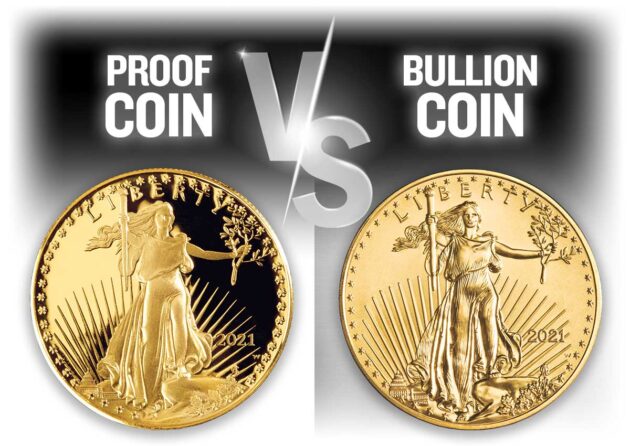
5.5 Uncirculated/Burnished Gold Eagles
In addition to standard bullion and proof editions, the U.S. Mint produces uncirculated Gold American Eagles, sometimes referred to as “burnished” Gold Eagles. Introduced in 2006, these coins occupy a middle ground between investment bullion coins and collector proof editions.
Production Process:
- Minted on specially burnished blanks that undergo a unique treatment process
- Blanks are tumbled in a solution of steel media before striking
- Each coin is hand-loaded into the coining press
- Struck only once (unlike proofs) but with greater pressure than standard bullion coins
- Feature a matte-like finish distinct from both bullion and proof editions
Distinctive Characteristics:
- Satiny, smooth appearance compared to the brilliant shine of bullion coins
- More detailed strike than standard bullion coins
- Includes the “W” mint mark (West Point), unlike standard bullion versions
- Usually features lower mintage numbers than bullion versions
Packaging and Certification:
- Comes in protective capsules and presentation boxes with certificates of authenticity
- Often includes special U.S. Mint packaging specific to the uncirculated program
- Many collectors maintain these coins in their original government packaging to preserve value
Collector Appeal:
- The uncirculated mintage was suspended during 2009-2010 due to financial crisis demand
- This interruption in the series has increased collector interest in complete sets
- First-year (2006) burnished Gold Eagles are particularly sought after by collectors
- Annual mintage is typically much lower than standard bullion coins, enhancing collectibility
Investment Consideration: Uncirculated Gold Eagles typically command premiums between standard bullion and proof editions, offering collectors an excellent middle option with both numismatic and intrinsic value potential.
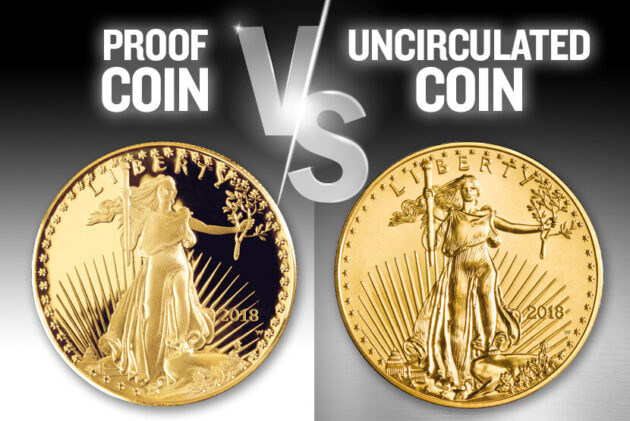
Did you know… The American Eagle Coin Program has expanded beyond gold to include silver (introduced alongside gold in 1986), platinum (first released in 1997), and palladium coins (launched in 2017)?
6. Conclusion: The Evolution of an American Treasure
The American Gold Eagle program, from its legislative inception in 1985 through today, represents one of the most successful government bullion programs in history. Born of political necessity and economic opportunity, it revived America’s gold coinage tradition with designs that honor the artistic legacy of the past while incorporating modern security and production technologies.
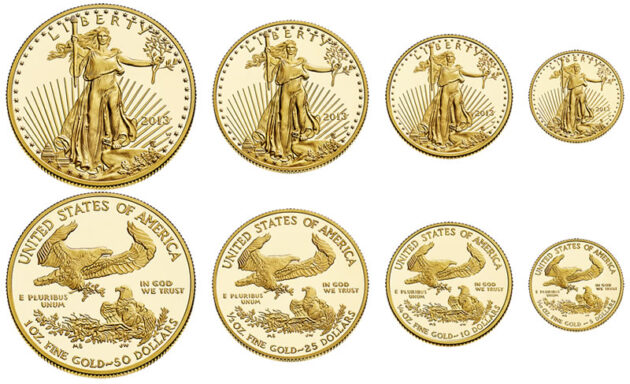
The program has continually evolved—from the initial release in 1986, through various special editions and finishes, to the significant design change and security enhancements of 2021 and beyond. Throughout these changes, the American Gold Eagle coin has maintained its core identity as a symbol of American heritage, artistic excellence, and economic strength.
As collectors and investors continue to appreciate these magnificent coins, they will remain a tangible connection to America’s artistic and numismatic heritage, combining historical symbolism with modern craftsmanship in a way few other products can match.
For more information on how Gold American Eagles can fit into your portfolio or retirement planning, contact a Colonial Metals Group specialist for a free consultation.





